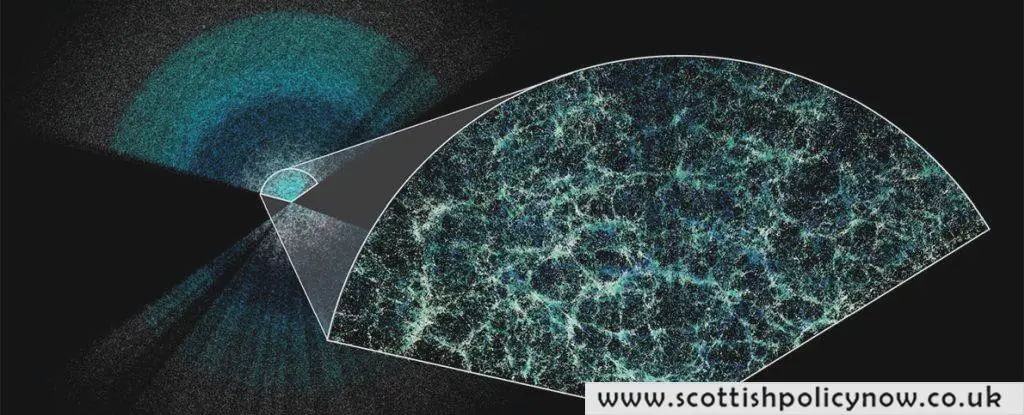The thick once again plottens in the quest to narrow down the expansion rate of the Universe.
A new measurement of the Universe’s accelerating expansion, known as the Hubble constant, has narrowed its rate to a velocity of 67.97 kilometers per second per megaparsec, with what a large international team of researchers says is the largest, most precise 3D map of our Universe to date.
It’s based on “bubbles” created by the expanding early Universe, and represents a significant achievement in both measuring the Hubble constant and searching for the mysterious dark energy that drives it… but it also deepens an ongoing crisis for cosmology.

That’s because two different ways of measuring the Hubble constant consistently produce two different ranges for results. These results, obtained using the Lawrence Berkeley National Laboratory’s Dark Energy Spectroscopic Instrument, are coming very close to ruling out human error, at least with this method.
“No spectroscopic experiment has had this much data before, and we’re continuing to gather data from more than a million galaxies every month,” says cosmologist Nathalie Palanque-Delabrouille of Berkeley Lab.
“It’s astonishing that with only our first year of data, we can already measure the expansion history of our universe at seven different slices of cosmic time, each with a precision of 1 to 3 percent.”
The Hubble tension – possibly the biggest problem in cosmology right now – arises from a discrepancy between results obtained using tools known as standard candles and standard rulers to measure the Hubble constant (H0).
As we have previously explained, standard candles are objects with known intrinsic brightness – Cepheid variable stars and Type Ia supernovae. If we know how intrinsically bright something is, we can calculate how far away it is, with high precision. Cepheid variable stars and Type Ia supernovae give us a Hubble constant of around 73 kilometers per second per megaparsec.
Standard rulers are based on signals from the early Universe. These include the cosmic microwave background – the light that first streamed through the Universe about 380,000 years after the Big Bang – and “bubbles” in space called baryon acoustic oscillations, or BAOs. These give a Hubble constant of around 67 kilometers per second per megaparsec.
BAOs, on which the DESI map was based, are basically spherical acoustic density waves that traveled through the plasma fog of the early Universe. When the fog cleared, the density of matter in the Universe was frozen in these spherical bubbles. Things have moved around, obviously, but spherical arrangements of galaxies can be identified, if you know what to look for.
The radius of these bubbles is fixed and known; it’s around 150 megaparsecs. So if astronomers see a BAO in distant space, since they know how big it is, they can also calculate how far away it is. And this allows for measurements of the Hubble constant.
In its survey of the sky, DESI peered an enormous 11 billion light-years into space-time, measuring BAOs as far as it could see. And, when combined with measurements of the cosmic microwave background, the results were firmly in the standard rule camp. Even without the CMB, however, the BAO measurement seems to rule out higher velocities.
“We tend to find values for H0 in the range of 67-68 kilometers per second per megaparsec, even when varying the assumptions of data sample or cosmic expansion history. These BAO data allow us to robustly say that the value of H0 is less than 70 kilometers per second per megaparsec when using a standard ruler calibrated from early Universe physics,” physicist Kyle Dawson of the University of Utah tells ScienceAlert.
“That leaves two possible explanations for the Hubble tension: there is new physics that must be accounted to properly calibrate the standard ruler from early Universe physics, or there are some sources of systematic error not properly considered in the bootstrapping of the SN+Cepheid measurements from local geometric distance estimates to distance estimates in the Hubble flow.”
The big problem here is that recent standard candle measurements made using the James Webb Space Telescope seem to be pretty solidly on Team 73 kilometers per second per megaparsec, and bridging the gap between the two with current measurements and data seems increasingly unlikely. That means new physics might be the answer, after all.
But this new measurement is just a step, based on just a single year of DESI data, which gives far better precision than what it took previous generation experiments 10 years to obtain. And it reveals some subtle deviations from the Lambda cold dark matter (LCDM) model of the Universe we currently use, which is based on specific models for both dark energy and dark matter.
“This added precision has placed us in the regime we have been seeking for 20 years, the regime where we can meaningfully test the nature of dark energy,” Dawson says.
“The results using only DESI BAO and CMB are best described with a model that deviates from the standard LCDM model by 2.6 sigma. While not yet the 3-sigma level that warrants evidence for new physics, this level of disagreement with the assumed model of the last 20 years has us all looking forward to the measurements with the three-year sample.
“We’ve demonstrated that the analysis techniques developed in this first year are robust and we expect the next measurements to be significantly more precise.”
We can’t wait.
The team has presented their results at the American Physical Society March Meeting, and made them available on preprint server arXiv.








